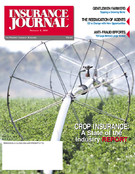Since its emergence just three years ago, the market for weather risks has become a significant new development on the radar screen of the reinsurance industry.
“Weather is essentially a new class of risk that is now being introduced to the risk transfer market that’s a very interesting and exciting area for growth,” said Paul Vander Marck, managing director for Menlo Park, Calif.-based Risk Management Solutions Inc. (RMS). While there is no hard source of data on numbers, estimates place cumulative volume in the $6- to $8-billion range and the annual trading volume currently in the $3- to $5-billion range.
At the same time that it manifests many fundamental similarities with the types of risks the reinsurance industry has traditionally dealt with, it can be argued that the weather risk market is the frontier of convergence between the insurance market and the financial market.
“If you look at how weather risk is traded, who’s involved in the market, it’s a very interesting mix of everybody from reinsurers to energy trading companies to investment fund managers all transacting and trading with each other,” Vander Marck said. “It’s traded as much more a financial commodity on an index basis with a robust secondary market.”
The initial motivation for development of the market is generally associated with the deregulation of the energy industry and the need of energy companies, like utilities, to manage weather risks, which constitute the single biggest risk in their business in terms of affecting supply and demand. However, the concept applies across a much broader range of industries.
“There are many, many industries besides energy, whether they’re beverage producers, clothing retailers or farmers, who have weather exposure, meaning weather affects the demand for their product,” Vander Marck said. “The market’s still clearly in a nascent stage where there’s a lot of change. There are certainly people who are questioning whether it will survive or whether it is just some sort of fad.”
This past summer, RMS—in collaboration with Earth Satellite Corp. (EarthSat), a leading provider of weather data, in particular real-time information and forecasts to the energy and agricultural commodities arenas—released an online risk management system for the weather market called Climetrix.
The application, which can be accessed through the website www.climetrix.com, is a blend of the experience RMS has developed over the years in the insurance world, building risk models used by underwriters to price deals and manage portfolios, with EarthSat’s capabilities in sourcing, processing and interpreting weather data. The end result is the delivery of a set of tools and products to different weather markets to help them better quantify their risks.
Featured is an historical catalog for the U.S. of enhanced weather data, which provides the fundamental basis for analyzing weather risks. The data has also been adjusted to take into account any issues such as changes over time in instruments used by weather stations to record temperatures.
“For example, weather stations have moved over time,” Vander Marck said. “When you change the instrument that records temperature at the weather station you may introduce a bias that temperatures are being recorded somewhat differently after the change than they were before. So if you just take all the raw historical data say for the last 30 or 40 years, they may be somewhat misleading relative to how temperatures are being recorded today.
“Our traditional business has been developing highly sophisticated models of natural catastrophes, like earthquakes and hurricanes,” Vander Marck continued. “We built very complex mathematical models, which have extensive amounts of data embedded in them. We provide those in the form of software tools to insurance and reinsurance underwriters and portfolio managers. In weather, our intent is to build a similar set of products.”
To clarify terminology, “weather” means daily fluctuations of things such as temperatures and precipitation, whereas hurricanes and major storms are categorized as catastrophe risks. The weather market covers deviations from an average. Accordingly, one of the most crucial elements in the weather market is to correctly quantify the risk that is actually associated with any given contract. Most trading occurs around two main seasons, winter and summer, with winter being the most significant in terms of the amount of risk to be hedged and what the activity is centered around.
Take, for example, a company running a pipeline that provides heating oil gas to New York City in the winter. The colder it is, the more people need heating oil to heat homes and businesses and the more revenue is generated for that company. If it is a warm winter, there is a risk that so little heating oil may be pulled through the company’s pipeline that revenues actually fall below the fixed cost of operating that pipeline. The risk, therefore, is that the company will be exposed to a warm winter, when the cumulative impact of temperature over a four- or five-month period negatively impacts revenues.
“That’s the sort of risk that the weather market is addressing,” Vander Marck said. “The weather market has been predominantly focused so far on temperature risk, covering variations in cold summers versus warm summers or cold winters versus warm winters. It’s also started branching to deal with things like precipitation risk, even stream flow risk.”
What is analyzed is the impact of daily weather conditions over a period of time, usually measured in months. Every individual business has its own unique exposure to weather—precipitation and temperature being the most common examples.
A transaction can be structured to cover a number of different types of weather variables. It can be structured to express the variation of those parameters from levels that can be set in a very specific manner for individual transactions to best address whatever risk an individual organization is facing.
In terms of temperature, there are degree days, specifically “heating degree days” and “cooling degree days,” which are essentially a way of measuring how far the temperature deviates from the baseline over a period of time. For a home or office, 65 degrees is typically where a thermostat would be set, and, in fact the market uses 65 degrees as a baseline.
“You might define a contract that covers heating or cooling degree days over the winter season,” Vander Marck explained. “You calculate every day how many heating or cooling degree days you have and add those up…That 65 degrees is a relevant baseline to use in the energy world because of how people use energy for heating and cooling. In other industries, different measures are ones that are more relevant to the risks people face.”
Transactions are customizable in terms of the region, the time period of the transactions, the level of precipitation or temperature or other variables.
Certain transactions—for example, those designed to cover the risk of citrus growers in Florida—are structured to be triggered when there are more than a certain number of days with minimum temperatures in the freezing range over a specific period of time. Other agriculture-based transactions might be related to the corn region in the upper Midwest of the U.S., where, at certain times of year, the corn crop is extremely sensitive to temperatures. In such cases, a contract can be structured with baseline temperatures adjusted accordingly.
“Relative to the heating and cooling degree terms, we’ve seen people make up terms of ‘growing degree days,'” Vander Marck said. “They define some baseline temperature, which is a good reference point for a particular type of crop where a deviation above or below that will have significant impact. Then they’ll structure some sort of deal based on that measure.”
The same thing could be done for precipitation, looking at cumulative precipitation over a period of months and structuring a deal where payouts could be received based on whether there is cumulative rainfall above or below certain thresholds.
A ski resort which wants to hedge the risk of having a bad winter in terms of low snowfall, can determine a threshold in terms of what level of snow would be bad for business. A transaction can then be structured that will cover the business if snow falls below that level.
The structure of transactions could also be based on what is called the “misery index,” a combination of temperature and humidity. Therefore, a theme park, by looking at its historical revenues and analyzing daily admissions statistics vs. weather, might identify that admission rates drop substantially when the misery index is very high because nobody wants to go out in that weather, and then hedge against that measure of weather.
“Our core offering is the ability for people to accurately understand the risk associated with a particular transaction so that the parties on both sides of the transaction have the best understanding possible of the inherent risk that’s being transferred and how it should be priced,” Vander Marck said. “The way we help people do that is a combination of data and modeling.”
As evidence of how the industry is responding to the opportunities presented by the weather risk market, Vander Marck pointed to the recent formation of Element Re, a new reinsurer backed by XL Capital Ltd. He described the move as “one of the more sophisticated, rapidly growing, well-capitalized reinsurance groups in the world putting their weight behind a pretty serious effort to build a weather-specific reinsurance operation.”
“A phenomenal number of businesses have weather risks,” Vander Marck concluded. “It’s exciting as a new market in an industry that’s been looking to expand more products it can offer to its clients and offer more holistic and comprehensive solutions.”
Topics Agribusiness Reinsurance
Was this article valuable?
Here are more articles you may enjoy.


 Three Charged With Helping Agents Cheat on Florida Insurance License Exams
Three Charged With Helping Agents Cheat on Florida Insurance License Exams  Let Good Adjusters, Not Expensive Lawyers, Make the Difference on Claims, CEO Says
Let Good Adjusters, Not Expensive Lawyers, Make the Difference on Claims, CEO Says  Supreme Court Overturns Chevron Rule in Blow to Regulators
Supreme Court Overturns Chevron Rule in Blow to Regulators  A $29 Billion Weed Market Fights to Diversify Amid Legal Hurdles
A $29 Billion Weed Market Fights to Diversify Amid Legal Hurdles 


